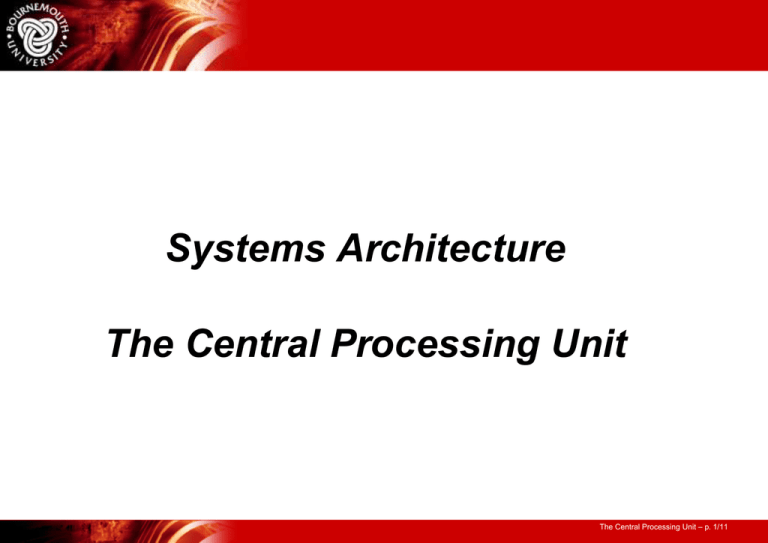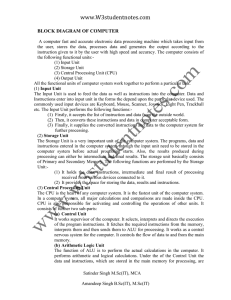Systems Architecture The Central Processing Unit
advertisement

Systems Architecture
The Central Processing Unit
The Central Processing Unit – p. 1/11
The Computer System
Application
High-level Language
Operating System
Assembly Language
Machine level
Microprogram
Digital logic
Hardware / Software
Interface
The Central Processing Unit – p. 2/11
CPU Structure
External Memory
MAR: Memory
Address Register
MBR: Memory
Buffer Register
Address
Incrementer
R15 / PC
R11
R7
R3
R14 / LR
R10
R6
R2
R13 / SP
R9
R5
R1
R12
R8
R4
R0
User Registers
Booth’s
Multiplier
Barrel
Shifter
IR
Control
Unit
CPSR
32-Bit ALU
The Central Processing Unit – p. 3/11
CPU Registers
Internal Registers
PC
Program Counter
IR
Instruction Register
MAR Memory Address Register
MBR Memory Buffer Register
CPSR Current Processor
Status Register
ALU
CU
M
MMU
Internal Devices
Arithmetic Logic Unit
Control Unit
Memory Store
Mem Management Unit
Condition Flags
C
Carry
Z
Zero
N
Negative
V
Overflow
User Registers
Rn Register n
n = 0 . . . 15
SP Stack Pointer
LR Link Register
Note that each CPU has a different set of User Registers
The Central Processing Unit – p. 4/11
Current Process Status Register
•
Holds a number of status flags:
N True if result of last operation is Negative
Z True if result of last operation was Zero or equal
C True if an unsigned borrow (Carry over) occurred
Value of last bit shifted
V True if a signed borrow (oVerflow) occurred
•
Current execution mode:
User Normal “user” program execution mode
System Privileged operating system tasks
Some operations can only be preformed
in a System mode
The Central Processing Unit – p. 5/11
Register Transfer Language
NAME
←
x:
(f ield)
Rn
num
2_num
0xnum
M(addr )
IR(f ield)
ALU(f ield)
Value of register or unit
Transfer of data
Guard, only if x true
Specific f ield of unit
(name), bit (n) or range (n:m)
User Register n
Decimal number
Binary number
Hexadecimal number
Memory Access (addr)
Specified f ield of IR
Specified f ield of the
Arithmetic and Logic Unit
← PC
hcci: MAR ← PC
ALU(C) ← 1
R0 ← MBR(0:7)
MAR
← MBR
R0 ← 128
R1 ← 2_0100 0001
R2 ← 0x40
MBR ← M(MAR)
CU ← IR(op-code)
ALU(C) ← 1
R0
The Central Processing Unit – p. 6/11
Control Unit
•
Controls operation of CPU
•
Decodes op-code field of IR
•
Two methods of implementation:
Microcode:
Random Logic:
•
Fairly slow
•
Very fast
•
Easy to design
•
Difficult to design
•
Very flexible
•
Fixed design
The Central Processing Unit – p. 7/11
Control Unit Implementation
•
Microcode
CPU within a CPU
Execute RTL-like microinstructions
op-code is pointer to microcode program
Has own microprogram ROM and CU
microCU implemented in random logic
•
Random Logic
Not Random rather different for each design
op-code decoded directly by boolean logic
All CPU control via boolean logic using
control, data, and address busses
The Central Processing Unit – p. 8/11
Assembler Code Terminology
Mnemonic
/ Directive
Label
z
}|
{ z
Main
label
}|
MOV
Operands
{ z
}|
r0, #0
Comment
{ z
}|
{
; move 0 into R0
Give a name to the location of the instruction
mnemonic Human readable name given to an instruction
MOV (Move) or LDR (Load Register)
operands
Arguments for a given instruction
effective address (Data or Memory)
directive
Instructions to the assembler
END (End of program source)
The Central Processing Unit – p. 9/11
Fetch / Execute Cycle
To perform a function the CPU must first fetch the
instruction from the main store before it can execute it.
For the instruction adds r0, r1, #2 the CPU would execute:
FETCH
EXECUTE
MAR
PC
MBR
IR
CU
ALU(0)
ALU(1)
ALU(cmd)
R0
hS i: CPSR
← PC
← PC + 4
← M(MAR)
← MBR
← IR(op-code)
move contents of PC to MAR
increment contents of PC
read instruction from memory
move instruction to IR
move op-code from IR to CU
← R1
← IR(op2)
← add
← ALU(ans)
← ALU(flags)
load ALU from R1
load ALU from second operand
ask ALU to add values
copy answer to R0
copy flags to PSR
The Central Processing Unit – p. 10/11
Instruction Format
•
All instructions include an operation code (op-code) field
•
Instructions fall into different “groups”
•
Each group of instructions has a different format
•
Instructions groupings in order of use:
Data Movement 45.28%
Logical
3.91%
Flow Control
28.73%
Shift
2.92%
Arithmetic
10.75%
Bit Manipulation 2.05%
Compare
5.92%
I/O & Others
0.44%
The Central Processing Unit – p. 11/11





